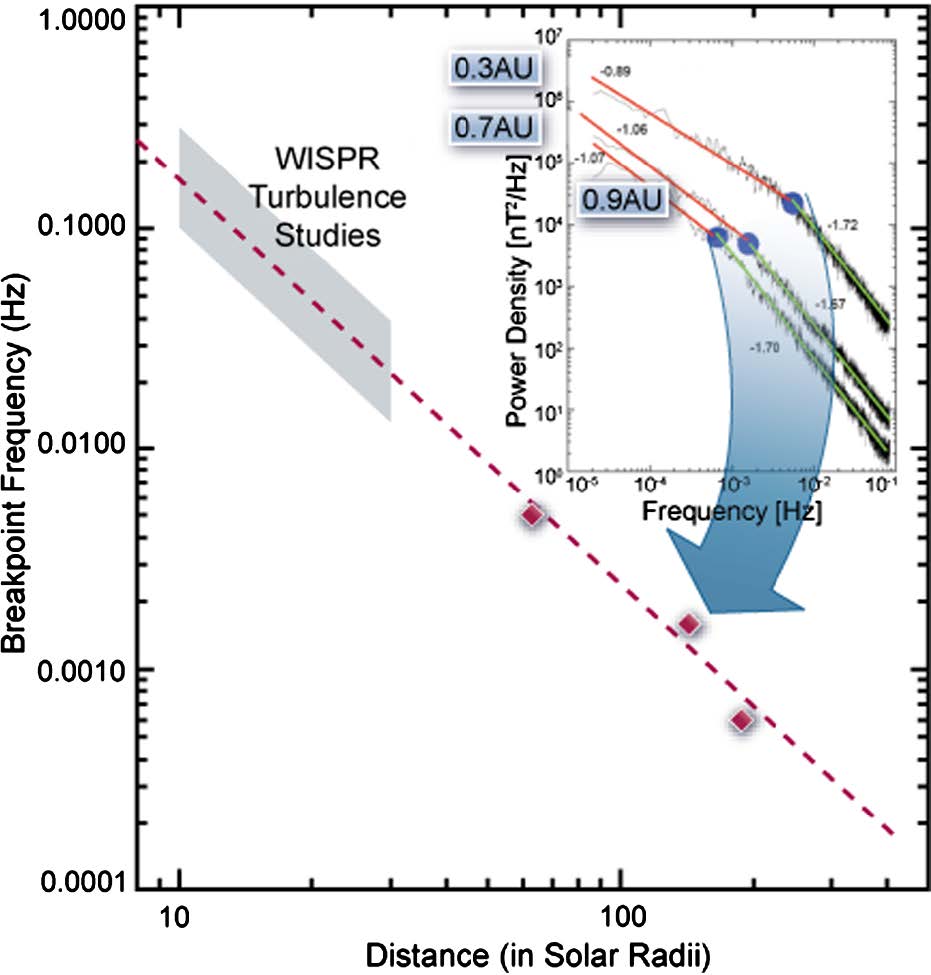‘How do the processes in the corona affect the properties of the solar wind in the heliosphere?’
While the slow wind appears to originate in streamers, the fast wind originates in the open magnetic fields of coronal holes. The Helios observations revealed that the latitudinal/ longitudinal edges of the high-speed solar wind streams from coronal holes are very sharp (Schwenn 1978), with gradients of 100 km/s/deg near 0.3 AU. The sharp edges are less apparent in the Ulysses and near-Earth data perhaps due to interplanetary dispersion on the trailing edges (the fastest plasma runs away from the slower plasma immediately behind it) and because of the change in profile on the leading edges. In contrast to Helios observations, theWang and Sheeley (1990) numerical model of the solar corona, which relates the expansion of magnetic flux tubes to the speed of the solar wind by assuming that the slow solar wind originates on the boundary of coronal holes, suggests that the latitudinal/longitudinal edges of streams near the Sun are broad regions with gradients of 20 km/s/deg.
WISPR observations will be able to clarify this debate, as it will image the change from low to high-density plasma that marks the transition from high to low speed solar wind. High-resolution white-light images by WISPR will be obtained inside 0.25 AU where, according to Parker spiral theory, the interface between fast and slow solar wind streams will be viewed edge-on. The boundary will appear as a brightness gradient, steepening slowly with increasing heliocentric distance. WISPR images will measure the thickness of the brightness gradient directly and, by tracking its co-rotation over several days, will determine its 3D topology and temporal evolution. Additionally WISPR will pass through the stream interfaces near 10 Rs and in-situ observations of the boundary thickness will be compared with white-light observations.

Turbulence is another way the corona affects the solar wind properties. Turbulent cascade, widely accepted as a mechanism for the generation of ion-cyclotron waves, has good theoretical and observational support (Hollweg 2008). However, the solar wind, and consequently its turbulence levels, evolves as the wind propagates away from the Sun, thus confusing or diluting signatures of the low corona acceleration processes and of the original wave spectrum. Energy is injected at low frequencies varying from days to months and cascades with a Kolmogorov power spectrum of f −5/3. Helios observations have shown that the breakpoint between the inertial and injection scales moves to higher frequencies closer to the Sun but the injection power spectrum maintains the f −1 spectrum (Fig. 6). The source of the f −1 spectrum is still under debate. Matthaeus and Goldstein (1986) have suggested that it originates from reconnection events in the corona and hence indicates the influence of reconnection in coronal heating. These results are based on solar wind velocity and magnetic field fluctuations. The density fluctuations are harder to interpret. At 1 AU, there is evidence of both turbulence and coherent structures contributing to the observed fluctuations (Viall et al. 2009). To separate them and trace their origins, two-dimensional imaging observations are required. In-situ density spectra exhibit f −1 and f −5/3 spectra (Marsch and Tu 1990) in close correspondence to magnetic field spectra, but they also exhibit 1/f 2 spectra.
We have only a basic idea of whether this behavior persists closer to the Sun. The main information is provided by density power spectra using interstellar scintillation (e.g., Coles and Harmon 1989) but the relation of the density fluctuations to ion-cyclotron waves is unclear and radio observations near the Sun are rare due to the lack of suitable radio sources and dedicated solar radio instruments. Recently, Bemborad et al. (2008) obtained remote imaging spectra with 1/f and 1/f 2 behavior in the Lyα line using SOHO/UVCS observations. However, the long integration times of 300 s, required to obtain the necessary sensitivity, restricted their study to low frequencies away from the spectral breakpoint. Such studies are further restricted by line-of-sight effects and uncertainties in the origin of the Lyα emission. However, they demonstrated the power of remote imaging by simultaneously obtaining spectra over a variety of longitudes, latitudes and heliocentric distances.
The SPP orbit offers many advantages for the pursuit of such measurements with WISPR based on our experience with the SECCHI/HI performance on solar wind structures. First, the proximity of SPP to the coronal structures allows much higher contrast observations with higher cadence than is possible from 1 AU. Second, the spectral breakpoint between injection and inertial scales is expected to drift from 100 s at 40 Rs down to 5 s at 9.5 Rs based on a simple extrapolation of the Helios measurements (Fig. 6). Both of these time-scales are easily within the WISPR capabilities. We have designed a specific WISPR observing program for this case. For example, prior to each solar encounter, we will use synoptic images from WISPR or other coronagraphs to predict when SPP will cross a solar wind structure of interest (e.g., an HPS boundary or a fast stream interface). For a specified time interval during the SPP perihelion (currently 10 min every hour), WISPR will obtain images over a restricted FOV around the region of interest with extremely high cadence (up to 1 s). A power spectrum of the density fluctuations can then be constructed with variable cadences for direct comparison to similar spectra obtained by the FIELDS instruments on SPP. WISPR will provide density power spectra at or below the spectral break between inertial and injection scales, even at the nearest perihelion approach. WISPR will provide many simultaneous spectra for different coronal structures and will monitor their evolution. When combined with the tomographic information from the synoptic images, the WISPR turbulence program will be a major enhancement to the turbulence measurements from the SPP in-situ instruments resulting in a much more robust understanding of the near-Sun turbulence.
